Managuan cichlazoma: description, content and compatibility
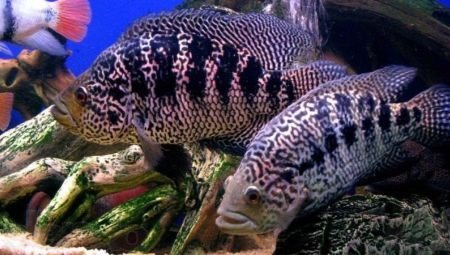
The Managuan cichlazoma is a predatory fish that belongs to the genus cichlazomas and the cichlid family. The genus cichlaz has about 100 species of fish. Many representatives of this genus are very popular aquarium fish all over the world. Another name for the Managuan cichlazoma is the jaguar cichlid... She received this name for the characteristic spots on the body, reminiscent of the color of a jaguar.

Where does it live in nature?
In the wild, the Managuan cichlazoma is found in Central America in rivers, lakes and warm bodies of water with stagnant water. There are especially many of these fish in the Ulua and Matina rivers, as well as in Lake Managua, from whose name the cichlazoma got its name. The first time this fish was described by the German zoologist Albert Gunther in 1867. In Mexico, Guatemala, Singapore and some other countries, reservoirs are populated with Managuan cichlazomas artificially, since they are commercial fish there.
Such actions are detrimental to local aquatic inhabitants, because this family is voracious predators that do not tolerate any neighbors nearby.
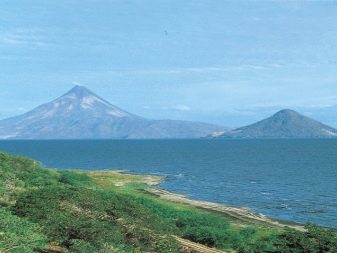
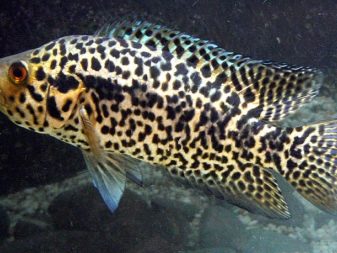
Appearance and behavior
In nature, the jaguar cichlid grows up to 60 cm and weighs several kg. In conditions of aquarium keeping, males reach 40-50 cm, females - no more than 35 cm. The body of these fish has an oval shape, it is elongated and compressed from the sides. Such a structure helps predatory fish to make rapid throws to prey.
In addition, they have pharyngeal teeth, and their sharp fin rays protect them from other predators. The Managuan cichlazes have a large head and an impressive mouth with thick lips.The eyes have a red iris.
Only adults have a spotted coloration; young fish have only dark stripes. With age, black and white spots fade and disappear, especially in males. In adulthood, they have sharper dorsal and anal fins than females and a very expressive bright color. The caudal fin is without lobes and has a rounded shape.
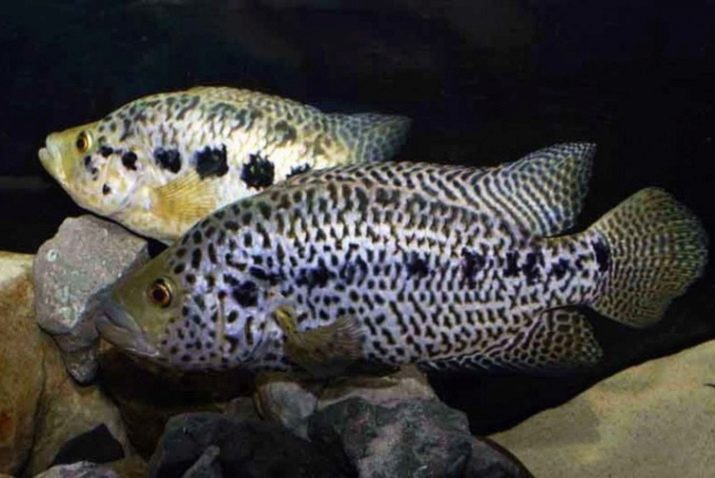
What should be the aquarium?
The Managuan cichlazoma is not a very difficult fish to keep at home. By creating comfortable conditions for its growth, you will receive an aquarium inhabitant, unique in its beauty and grace. In order for the jaguar cichlid to live in captivity for as long as possible, it needs suitable conditions.
- The volume of the aquarium. It should be at least 100 liters for one fish, for a couple - at least 300 liters. If the cichlase is more than 2, then you need a capacity of 600 liters.
- Temperature. Recommended water temperature is 24-28 ° C. In warmer waters, fish become very aggressive.
- Water composition. For this type of aquarium fish, water with an acidity of 7.0–8.7 pH and a hardness of 10–15 is suitable. Since these are predatory inhabitants, and they feed mainly on live food, the water is quickly polluted. It is necessary to purchase a powerful filter and change 40% of the water every week. Ensure good aeration as well.
- Lighting. Managuan cichlazomas do not require very bright lighting. To dim the light, you can plant duckweed on the surface or put well-washed oak leaves.
- Priming. Large gravel or medium-sized pebbles are most suitable for these fish, as they love to move small pebbles along the bottom. The soil must be treated so that it does not injure the cichlase. You can put driftwood, shells, large stones in it, but it is better to fix them properly.
- Plants. Managuan cichlazomas destroy vegetation, as they dig the bottom all the time. You can try to get Canadian elodea or hornwort, because they do not need rooting, and they grow quickly. Alternatively, you can place artificial algae.
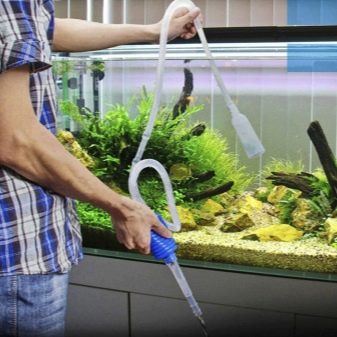
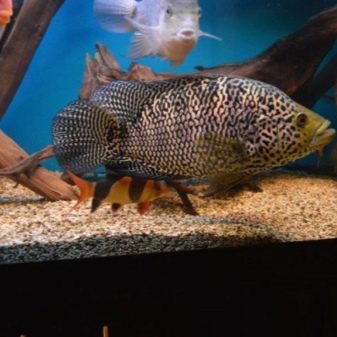
Feeding
The diet of jaguar cichlids should be balanced and varied. It is recommended to feed them once a day, once a week you can skip feeding them. Despite the fact that in the wild these fish eat live food, in the conditions of the aquarium they need to be given dry food.
From living creatures, tadpoles, small fish, insects are suitable. You can give meat by-products and semi-finished products.
But experts do not advise feeding Managuan cichlazes with large amounts of pork and beef, since fish digest this food very hard.

Reproduction
Cichlazoma Managuan is a spawning fish. At the age of 10 months, the male can be clearly distinguished from the female. It has a rougher body, a larger head, a more pronounced dorsal tubercle, and the dorsal fin is painted in emerald color, golden colors prevail in color (in the female - silvery). These fish reach sexual maturity at the age of 1 year. It is desirable that both future parents grow up together, otherwise the male may kill an unfamiliar female.
The male builds and guards the nest, in which the female lays eggs during spawning. The water temperature can be raised to 28 °, no other fish should be in the aquarium. The female lays about 3000 golden eggs and takes care of them. On the 3-4th day fry appear.
The first days they do not need food, then they should be fed with special food, as well as small crustaceans, daphnia and brine shrimp.
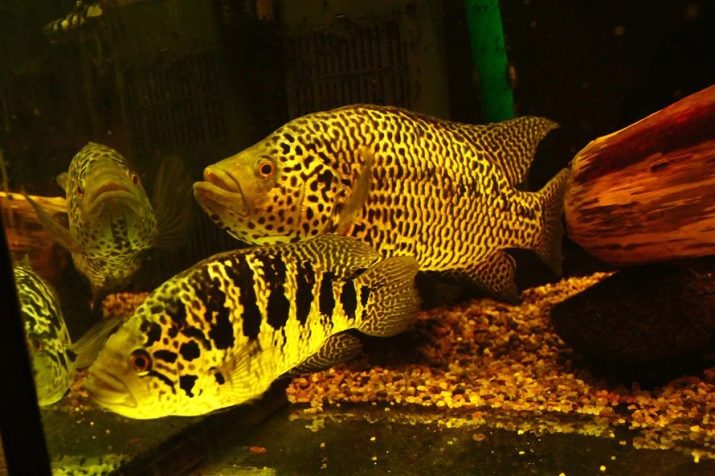
Possible diseases
All members of the cichlid family have good natural immunity, their diseases are most often the result of improper care. You should be aware that these fish are sensitive to the composition of the water. It should not contain an increased concentration of proteins and substances containing nitrogen. If the color of the cichlazoma has become dark, and the fish nervously quickly moves through the aquarium, then you need to immediately replace a third of the volume of water.
Poor quality feed can often become a source of infection. The jaguar cichlid must be planted separately and treated with medications.
Remember, after purchasing new fish, be sure to quarantine them in a separate aquarium in order to identify possible health problems.
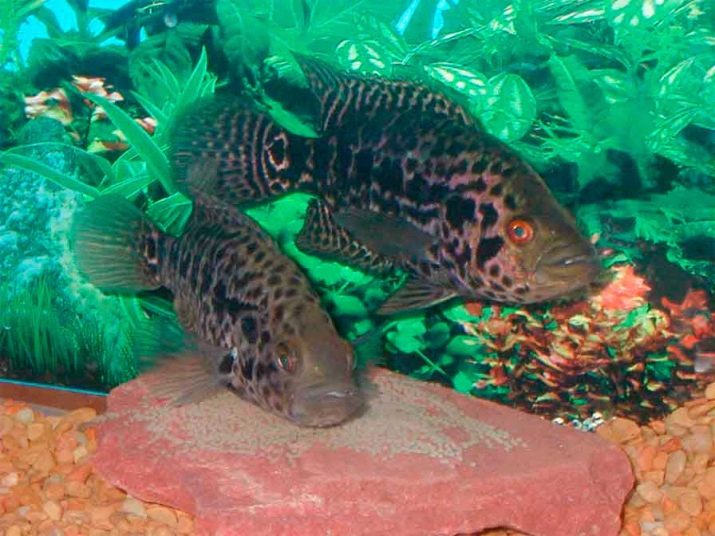
Co-location
It should not be forgotten that the Managuan cichlazoma is a predatory and aggressive fish that selflessly protects its territory, and becomes even more aggressive during spawning. Therefore, it can only be kept in an aquarium with large cichlids of other species or with large aquarium catfish, for example, Clarius or Pangasius. There are known cases of compatibility of the jaguar cichlid with giant gouras and black pacu. It is strongly not recommended to put small fish into an aquarium with Managuan cichlazomas: they will be eaten right there.
The Managuan cichlazoma is a very beautiful large fish that looks spectacular in a large aquarium. Caring for her is not very difficult, besides, she has good immunity by nature. Under the right conditions, these beautiful jaguar-colored predators can live in home aquariums for about 15 years.

For more information on the features of these fish, see the next video.








